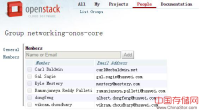一.Neutron和ONOS集成
1、Neutron和ONOS社区动态
首先,我们可以从Neutron项目中的doc/source/policies/neutron-teams.rst文件看到,onos和neutron集成项目的相关开发者信息。其Master是一位来自华为印度班加罗尔地区的Vikram Choudhary,负责主导该项目的开发工作。
| Area | Lieutenant | IRCnick |
| networking-odl | FlavioFernandes | Flaviof |
| KyleMestery | mestery | |
| networking-onos | VikramChoudhary | vikram |
是的,该项目的主导团队,正是来自于华为,当然也包括中国区的开发者们。
如下图所示,我们还能在review.openstack官网上,看到该项目(networking-onos)的全部Core Reviews。如下图1所示

首先,我们git clone最新的neutron项目代码,从doc/source/stadium/sub_projects.rst文件中,我们可以清晰的看到目前诸如odl、onos之类的sdn plugin在Neutron中的作用和角色定位。比如,odl的角色是在Neutron中担负ML2层、L3层、负载均衡和防火墙这四类资源操作和管理的实现。如下表所示。
| Name | Functionality |
| networking-onos_ | ml2 |
| networking-odl | ml2,l3,lb,fw |
这里,值得我们注意的是,事实上,ONOS并不只是实现ML2层的资源,还包括了L3层等资源。应该是由于onos社区这方面的开发尚未结束或openstack社区对于这块文件未及时更新。
在Neutron中,诸如odl、onos之类的sdn plugin 均是以mechanism_drivers的方式,和ML2、L3等之类的网络服务集成,来提供各种功能。而每一个mechanism_drivers都需要实现type_drivers中的各种网络模型,比如我们常用的vlan、vxlan等。Setup.cfg代码选取如下:
Shell| 123456789 | neutron.ml2.type_drivers = flat = neutron.plugins.ml2.drivers.type_flat:FlatTypeDriver local = neutron.plugins.ml2.drivers.type_local:LocalTypeDriver vlan = neutron.plugins.ml2.drivers.type_vlan:VlanTypeDriver geneve = neutron.plugins.ml2.drivers.type_geneve:GeneveTypeDriver gre = neutron.plugins.ml2.drivers.type_gre:GreTypeDrivervxlan = neutron.plugins.ml2.drivers.type_vxlan:VxlanTypeDriverneutron.ml2.mechanism_drivers = linuxbridge = neutron.plugins.ml2.drivers.linuxbridge.mech_driver.mech_linuxbridge:LinuxbridgeMechanismDriver |
2.Neutron和ONOS集成实践
我的实践环境,由VMware WorkStations 11搭建的2台VM,具体如下:
| ONOS平台 | OpenStack平台 |
| Ubuntu14.04 | CentOS7.1 |
| ONOS1.3.0 | OpenstackLiberty(支持Kilo),由Rdo安装的All-in-one |
| 10.0.0.29 | 10.0.0.19 |
友情提示:关于ONOS和OpenStack环境的搭建,SDNLAB上已有丰富的资料,可参考。
在集成之前,请确保你的相关服务是正常运行中的。如下图

1)安装networking-onos(OpenStack Controller Node)
| 1 | # pip install networking-onos |
2)配置ml2_conf.ini文件(OpenStack Controller Node)
Shell| 12345678910111213141516 | # vim /etc/neutron/plugins/ml2/ml2_conf.ini[ml2]type_drivers = vxlantenant_network_types = vxlanmechanism_drivers = onos_ml2...[ml2_type_vxlan]vni_ranges = 1001:2000...[secutirygroup]enable_security_group = True...[onos]url_path = http://10.0.0.29:8181/onos/vtn # IP请换成你自己的ONOS_IPusername = karafpassword = karaf |
3)更新配置文件(OpenStack Controller Node)
Shell| 1 | # neutron-db-manage --config-file /etc/neutron/neutron.conf --config-file /etc/neutron/plugins/ml2/ml2_conf.ini upgrade head |

4)重启Neutron服务(OpenStack Controller Node)
| 1 | # systemctl restart neutron-server.service |
注意:
如果在配置ONOS driver和Neutron集成时,提示错误,请查看如下日志文件。
/var/log/neutron/server.log
5)在ONOS命令行中安装所需要的功能
Shell| 1234 | onos> feature:install onos-ovsdatabaseonos> feature:install onos-app-vtnrsconos> feature:install onos-app-vtnonos> feature:install onos-app-vtnweb |
6)检查ONOS VTN 功能
浏览器中访问:http://10.0.0.29:8181/onos/vtn/subnets #请换成你自己的ONOS_IP
你会得到一个如下面一样的空的json输出
{"subnets":[]}

7)设置网桥连接(OpenStack Network/Compute Nodes)
如果你的OpenStack平台,既有计算节点,也有网络节点,请分别运行如下命令设置。
| 12345 | # ovs-vsctl set-manager tcp:10.0.0.29:6640 #请换成你自己的ONOS_IP</p>使用ovs-vsctl show命令,检查设置情况。 # ovs-vsctl show2924ffa8-cad5-469c-a4c6-6785e79036ac Manager "tcp:10.0.0.29:6640" |
8)在Horizon 上,创建一个network和subnet。下图是我创建的一个结果。

9)使用REST client检查REST。这里,我使用的是Google的Postman插件。
输入URL:http://10.0.0.29:8181/onos/vtn/subnets #请换成你自己的ONOS_IP
正常情况下,你应该得到如下输出
| 123456789101112131415161718192021222324 | {"subnets": [{"id": "6a3e9b3c-7993-4b85-a5b8-f225ff68a8d7","gateway_ip": "10.0.0.2","network_id": "e376be13-481b-481d-818b-aed4d9fce8a5","name": "external_subnet","ip_version": "INET","cidr": "10.0.0.0/24","shared": true,"enabled_dchp": false,"tenant_id": "5e7d2d5df0534fb087aac1b6f7bf8ca4","ipv6_address_mode": null,"ipv6_ra_mode": null,"allocation_pools": [{"start": "10.0.0.100","end": "10.0.0.150"}],"host_routes": [ ]}]} |
10)在VXLAN模式下,创建一个可以ping通外网的虚拟机。

11)使用REST Client,使用GET方法获取REST Port
http://10.0.0.29:8181/onos/vtn/ports
12)登录ONOS UI。Topology上查看link br-int to br-int;vm to br-int
http://10.0.0.29:8181/onos/ui
13)Flow验证
由于onos集成neutron,不支持br-tun隧道。因此,环境中的br-int充当了br-tun的功能和角色。如果,你的环境中既有计算、也有网络节点,请分别在网络和计算节点上查看Flow。
由于,我部署的是all-in-one平台,因此运行一次即可。
| 123456789 | # ovs-ofctl dump-flows br-int #如果你指定的协议是openflow13,请添加参数 –O openflow13NXST_FLOW reply (xid=0x4):cookie=0x82a481adf93d8421, duration=747.216s, table=0, n_packets=0, n_bytes=0, idle_age=747, priority=10,icmp6,in_port=8,icmp_type=136 actions=resubmit(,24)cookie=0x82a481adf93d8421, duration=747.201s, table=0, n_packets=4, n_bytes=168, idle_age=424, priority=10,arp,in_port=8 actions=resubmit(,24)cookie=0x82a481adf93d8421, duration=2635.490s, table=0, n_packets=372, n_bytes=40966, idle_age=424, priority=0 actions=NORMALcookie=0x82a481adf93d8421, duration=2635.480s, table=23, n_packets=0, n_bytes=0, idle_age=2635, priority=0 actions=dropcookie=0x82a481adf93d8421, duration=747.226s, table=24, n_packets=0, n_bytes=0, idle_age=747, priority=2,icmp6,in_port=8,icmp_type=136,nd_target=fe80::f816:3eff:fec3:e7a3 actions=NORMALcookie=0x82a481adf93d8421, duration=747.209s, table=24, n_packets=4, n_bytes=168, idle_age=424, priority=2,arp,in_port=8,arp_spa=192.168.0.3 actions=NORMALcookie=0x82a481adf93d8421, duration=2635.469s, table=24, n_packets=0, n_bytes=0, idle_age=2635, priority=0 actions=drop |
3、目前已知的集成问题
1) 不支持br-tun
onos-ovsdatabase (sudo ovs-vsctl set-manager tcp:ONOS_IP:6640)
- tunnel create using br-int
management network
- 不支持data network
2) Buffalo SW(个人理解是指物理的网络扩展)
- Buffalo SW is OpenWRT
install OVS
- Buffalo SW connect ONOS(该OpenFlow交换机是一个物理交换机)
sudo ovs-vsctl set-controller
二、如何和ONOS社区建立互动
如上述的图1所示,是ONOS和Neutron集成项目(networking-onos)的核心开发者姓名和邮件,如有问题可以通过邮件方式进行沟通,放心,开发者们都很及时和热心的。
此外,还可以在ONOS的官网论坛上,发帖讨论(地址:http://forum.onosfw.com)。
ONOS与OpenStack相关的blueprints地址:
https://blueprints.launchpad.net/neutron/+spec/onos-neutron-interaction
networking-onos 在github上的地址:
https://github.com/openstack/networking-onos
小结
本次实验环节中比较突出的现象是,将mechanism_drivers的默认openvswitch,替换为onos_ml2后,在网络的使用方面,感觉不是很稳定。当然,或许该技术目前只是初期阶段吧(2015年3月立项),我们也有理由相信,它会变得更好。
从个人角度而言,诸如LB、FW、VPN、ML2、L3之类的网络服务,Neutron本身就已经实现了,之所以可以用sdn plugin去替换它们来实现。不仅只是让用户更加多了一种选择,而且在其应对大规模的复杂网络、网络调优/计算时更加显得突出——相信这也是众多SDN/NFV Plugin项目的初衷之一吧!
最后,需要指出的是,本次实践的成功,离不开社区开发者们的努力和帮助,尤其是华为的那些朋友们!在此,一并表示感谢!
作者简介:
徐超:2015——至今,从事OpenStack相关工作。个人倾向于研究OpenStack、SDN和Docker。